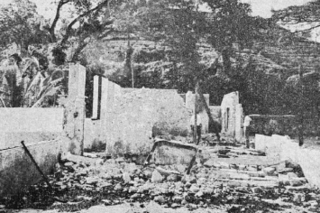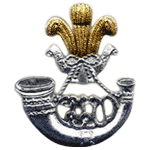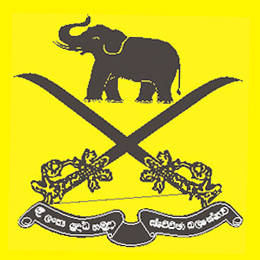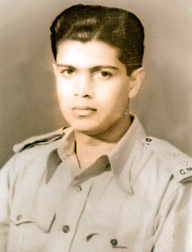
The 1971 Janatha Vimukthi Peramuna (JVP) insurrection was the first of two unsuccessful armed revolts conducted by the communist Janatha Vimukthi Peramuna (JVP) against the socialist United Front Government of Sri Lanka under Prime Minister Sirimavo Bandaranaike. The revolt began on 5 April 1971 and lasted until June of that year. The insurgents held towns and rural areas for several weeks, until the regions were recaptured by the armed forces, following strong support from friendly nations that sent men and material. Although this first attempt to seize power was quickly crushed by force, in 1987 the JVP launched a low-intensity insurgency in the island's southern, central and western regions that lasted several years.

The Sri Lanka Army is the oldest and largest of the Sri Lanka Armed Forces. Established as the Ceylon Army in 1949, it was renamed when Sri Lanka became a republic in 1972. In 2010, the Army had approximately 200,000 regular personnel, between 20,000 and 40,000 reserve (volunteer) personnel and 18,000 National Guardsmen and comprises 13 divisions, one air-mobile brigade, one commando brigade, one special forces brigade, one independent armored brigade, three mechanized infantry brigades and over 40 infantry brigades.

The Sri Lanka Artillery (SLA) is the artillery arm of the Sri Lanka Army. It is made up of ten regular regiments and two volunteer regiments. The SLA is headquartered at Panagoda Cantonment, Panagoda.

The Sri Lanka Light Infantry (SLLI) is the oldest regiment in the Sri Lanka Army and the oldest infantry regiment in the army. It is made up of sixteen regular battalions and nine volunteer battalions, and is headquartered at the Panagoda Cantonment, Panagoda.
Premawathi Manamperi was a woman from Kataragama, Sri Lanka. She was arrested on suspicion of leading a rebel group that disturbed the country in 1971. That year, she was handed over to the army where she was tortured, possibly raped and paraded naked through the streets, and killed. Her death is a prominent event in Sri Lankan crime history.

The Sri Lanka Army Volunteer Force (SLAVF) is the active-duty volunteer reserve force of the Sri Lanka Army. The SLAVF is separate from the Regular Force which consists of personal who are professional soldiers and its Regular Reserve, which comprises personal who have a mobilization obligation following their service in the regular army. The SLAVF consists of the volunteer force and the volunteer reserve; administration and recruitment of reserve personal is carried out by the Volunteer Force Headquarters in Shalawa, Kosgama which is headed by the Commandant of the Volunteer Force. It has a current strength of about 55,000 personnel. The SLAVF was known as the Ceylon Volunteer Force from 1949 to 1972 and the Sri Lanka Volunteer Force from 1972 to 1985.

The Sri Lanka Army Medical Corps (SLAMC) (Sinhala: ශ්රී ලංකා යුද හමුදා වෛද්ය බලකාය Shri Lanka Yuddha Hamuda Vayidya Balakaya) is a specialist corps in the Sri Lanka Army which specializes in military medicine and provides medical services to all army personnel and their families in war and in peace. It is made up of 4 regular units and one volunteer unit. Headquartered in Colombo, formally at army headquarters. The corps Cap badge depicting the Rod of Asclepius. General officers and senior officers of the SLMC wear gorget patches of maroon rather than of scarlet worn by other officers of similar rank.
General Shantha H.S. Kottegoda, WWV, RWP, RSP, VSV, USP is a retired senior Sri Lanka Army general. He was the seventeenth commander of the Sri Lankan Army from 1 July 2004 – 5 December 2005. He had served as the Sri Lankan Ambassador to Brazil and Thailand. In April 2019, following the Easter Sunday bombings he was appointed as the permanent secretary to the Ministry of Defence.
Major General Y. Balaretnarajah, VSV, USP, ndc is a retired Sri Lankan army officer. He had served as Chief of Staff of the Sri Lanka Army, Commandant of the Volunteer Force and Commander - Jaffna Security Forces. He has commanded the 1 Division, Armoured Brigade, 21 Brigade and 24 Brigade.

General Anuruddha Leuke Ratwatte, frequently referred to as Anuruddha Ratwatte, was a Sri Lankan soldier and politician. He was a Cabinet Minister and Deputy Minister of Defence.
General Hamilton Wanasinghe, VSV was a General in the Sri Lanka Army. He served as the 11th Commander of the Sri Lankan Army (1988–1991), third General Officer Commanding (GOC) of the Joint Operations Headquarters (JOH) (1991–1993) and Defense Secretary.

General Lionel Piyananda Balagalle,, was a senior Sri Lanka Army officer, who served as the Commander of the Sri Lanka Army and the Chief of the Defence Staff. He is known for formalising military intelligence operations within the Sri Lanka Army, having founded the Directorate of Military Intelligence and the Military Intelligence Corps.

General L. D. E. Cecil Waidyaratne, VSV, USP was a Sri Lanka Army general. He was 12th Commander of the Sri Lankan Army and a former Sri Lankan Ambassador to Thailand.
General Gerard Hector "Gerry" de Silva, RWP, VSV, USP was a senior Sri Lanka Army officer. He is the 5th Chancellor of General Sir John Kotelawala Defence University since 20 January 2020. He was the 13th Commander of the Sri Lankan Army and Sri Lankan High Commissioner to Pakistan.

Colonel Candauda Arachchige Dharmapala, OBE, ED was Sri Lankan politician. He was a Parliamentary Secretary to the Minister of Industries, Housing and Social Services and Member of Parliament for Hakmana. He also served as the permanent secretary to the Ministry of Defence, and as Security Adviser to President J. R. Jayewardene.
Colonel Derrick Nugawela was a Sri Lankan army officer, planter and banker.
Colonel Sooriyaratne Douglas Ratwatte, ED was a Sri Lankan army officer. He was the Commandant of the Volunteer Force.
Major General Hikkaduwage Gratian Silva, VSV, FBIM was a Sri Lankan military leader, he served as the Military Secretary.
Colonel Alan Tollence Nugawela (19??-2007) was a Sri Lankan army officer and a planter.










